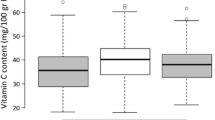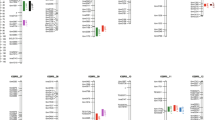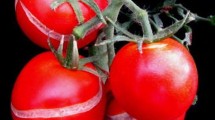Abstract
Key message
Agronomical characterization of a RIL population for fruit mineral contents allowed for the identification of QTL controlling these fruit quality traits, flanked by co-dominant markers useful for marker-assisted breeding.
Abstract
Tomato quality is a multi-variant attribute directly depending on fruit chemical composition, which in turn determines the benefits of tomato consumption for human health. Commercially available tomato varieties possess limited variability in fruit quality traits. Wild species, such as Solanum pimpinellifolium, could provide different nutritional advantages and can be used for tomato breeding to improve overall fruit quality. Determining the genetic basis of the inheritance of all the traits that contribute to tomato fruit quality will increase the efficiency of the breeding program necessary to take advantage of the wild species variability. A high-density linkage map has been constructed from a recombinant inbred line (RIL) population derived from a cross between tomato Solanum lycopersicum and the wild-relative species S. pimpinellifolium. The RIL population was evaluated for fruit mineral contents during three consecutive growing seasons. The data obtained allowed for the identification of main QTL and novel epistatic interaction among QTL controlling fruit mineral contents on the basis of a multiple-environment analysis. Most of the QTL were flanked by candidate genes providing valuable information for both tomato breeding for new varieties with novel nutritional properties and the starting point to identify the genes underlying these QTL, which will help to reveal the genetic basis of tomato fruit nutritional properties.

Similar content being viewed by others
References
Achilea O (1998) Citrus and tomato quality is improved by optimized K nutrition. In: Improved crop quality by nutrient Management. Anac D, Martin-Prevel P (eds). Kluwer Academic Publishers, The Netherlands, p 19–22
Alba JM, Montserrat M, Fernández-Muñoz R (2009) Resistance to the two-spotted spider mite (Tetranychus urticae) by acylsucroses of wild tomato (Solanum pimpinellifolium) trichomes studied in a recombinant inbred line population. Exp Appl Acarol 47:35–47. doi:10.1007/s10493-008-9192-4
Al-Delaimy WK, Ferrari P, Slimani N, Pala V, Johansson I, Nilsson S, Mattisson I, Wirfalt E, Galasso R, Palli D, Vineis P, Tumino R, Dorronsoro M, Pera G, Ocké MC, Bueno-de-Mesquita HB, Overvad K, Chirlaque M, Trichopoulou A, Naska A, Tjønneland A, Olsen A, Lund E, Alsaker EH, Barricarte A, Kesse E, Boutron-Ruault MC, Clavel-Chapelon F, Key TJ, Spencer E, Bingham S, Welch AA, Sanchez-Perez MJ, Nagel G, Linseisen J, Quirós JR, Peeters PH, van Gils CH, Boeing H, van Kappel AL, Steghens JP, Riboli E (2005) Plasma carotenoids as biomarkers of intake of fruits and vegetables: individual-level correlations in the European Prospective Investigation into Cancer and Nutrition (EPIC). Eur J Clin Nutr 59:1387–1396. doi:10.1038/sj.ejcn.1602252
Bach-Faig A, Berry EM, Lairon D, Reguant J, Trichopoulou A, Dernini S, Medina FX, Battino M, Belahsen R, Miranda G, Serra-Majem L (2011) Mediterranean diet pyramid today. Science and cultural updates. Public Health Nutr 14:2274–2284. doi:10.1017/S1368980011002515
Borguini RG, Torres EAFD (2009) Tomatoes and tomato products as dietary sources of antioxidants. Food Rev Int 25:313–325. doi:10.1080/87559120903155859
Capel C, Fernández del Carmen A, Alba JM, Lima-Silva V, Hernández-Gras F, Salinas M, Boronat A, Angosto T, Botella MA, Fernández-Muñoz R, Granell A, Capel J, Lozano R (2015) Wide-genome QTL mapping of fruit quality traits in a tomato RIL population derived from the wild-relative species Solanum pimpinellifolium L. Theor Appl Genet 128:2019–2035. doi:10.1007/s00122-015-2563-4
Capel C, Yuste-Lisbona FJ, López-Casado G, Angosto T, Cuartero J, Lozano R, Capel J (2017) Multi-environment QTL mapping reveals genetic architecture of fruit cracking in a tomato RIL Solanum lycopersicum × S. pimpinellifolium population. Theor Appl Genet 130:213–222. doi:10.1007/s00122-016-2809-9
Chapagain BP, Wiesman Z (2004) Effect of potassium magnesium chloride in the fertigation solution as partial source of potassium on growth, yield and quality of greenhouse tomato. Sci Hortic 99:279–288. doi:10.1016/S0304-4238(03)00109-2
Cosmulescu S, Baciu A, Botu M, Achim G (2010) Environmental factors’ influence on walnut flowering. Acta Hortic 861:83–88. doi:10.17660/ActaHortic.2010.861.10
Dar RA, Sharma JP (2011) Genetic variability studies of yield and quality traits in tomato (Solanum lycopersicum L.). Int J Plant Breed Genet 5:168–174. doi:10.3923/ijpbg.2011.168.174
Davies JN, Hobson LE (1981) The constituents of tomato fruit, the influence of environment, nutrition and genotype. Crit Rev Food Sci Nutr 15:205–280. doi:10.1080/10408398109527317
deVicente MC, Tanksley SD (1993) QTL analysis of transgressive segregation in an interspecific tomato cross. Genetics 134:585–596
Dorais M, Papadopoulos AP, Gosselin A (2001) Greenhouse tomato fruit quality. Hortic Rev 26: 239–319. doi:10.1002/9780470650806.ch5
Fernández-Muñoz R, Dominguez E, Cuartero J (2000) A novel source of resistance to the two-spotted spider mite in Lycopersicon pimpinellifolium (Jusl.) Mill.: its genetics as affected by interplot interference. Euphytica 111:169–173. doi:10.1023/A:1003893432676
Fernández-Ruiz V, Galiana L, Sánchez-Mata MC, Chaya C, Roselló S, Cámara M, Torija ME, Nuez F (2004) Internal quality characterization of fresh tomato fruits. HortScience 39:339–345
Fernández-Ruiz V, Olives AI, Cámara M, Sánchez-Mata Mde C, Torija ME (2011) Mineral and trace elements content in 30 accessions of tomato fruits (Solanum lycopersicum L.,) and wild relatives (Solanum pimpinellifolium L., Solanum cheesmaniae L. Riley, and Solanum habrochaites S. Knapp & D.M. Spooner). Biol Trace Elem Res 141:329–339. doi:10.1007/s12011-010-8738-6
Fraga CG (2005) Relevance, essentiality and toxicity of trace elements in human health. Mol Aspects of Med 26: 235–244. doi:10.1016/j.mam.2005.07.013
Guil-Guerrero JL, Rebolloso-Fuentes MM (2009) Nutrient composition and antioxidant activity of eight tomato (Lycopersicon esculentum) varieties. J Food Compos Anal 22:123–129. doi:10.1016/j.jfca.2008.10.012
Helyes L, Lugasi A, Pogonyi Á, Pék Z (2009) Effect of variety and grafting on lycopene content of tomato (Lycopersicon Lycopersicum L. Karsten) fruit. Acta Aliment 38:27–34. doi:10.1556/AAlim.2008.0013
Irving JT (1973) Calcium and phosphorus metabolism. Academy Press, New York
King JC, Shames DM, Woodhouse LR (2000) Zinc homeostasis in humans. J Nutr 130:1360S–1366S
Kosambi DD (1944) The estimation of map distances from recombination values. Ann Eugen 12:172–175. doi:10.1111/j.1469-1809.1943.tb02321.x
Lansdown AB, Mirastschijski U, Stubbs N, Scanlon E, Agren MS (2007) Zinc in wound healing: theoretical, experimental, and clinical aspects. Wound Repair Regen 15:2–16. doi:10.1111/j.1524-475X.2006.00179.x
Lavelli V, Peri C, Rizzolo A (2000) Antioxidant activity of tomato products as studied by model reactions using xanthine oxidase, myeloperoxidase and copper-induced lipid peroxidation. J Agric Food Chem 48:1442–1448. doi:10.1021/jf990782j
Maršić NK, Gašperlin L, Abram V, Budič M, Vidrih R (2011) Quality parameters and total phenolic content in tomato fruits regarding cultivar and microclimatic conditions. Turk J Agric For 35:185–194. doi:10.3906/tar-0910-499
McCormack E, Tsai YC, Braam J (2005) Handling calcium signaling: Arabidopsis CaMs and CMLs. Trends Plant Sci 10:383–389. doi:10.1016/j.tplants.2005.07.001
Moreiras O, Carvajal A, Cabrera L, Cuadrado C (2011) Tabla de Composición de Alimentos. Pirámide, Madrid
Oltman AE, Yates MD, Drake MA (2016) Preference mapping of fresh tomatoes across 3 stages of consumption. J Food Sci 81:1495–1505. doi:10.1111/1750-3841
Pinela J, Barros L, Carvalho AM, Ferreira IC (2012) Nutritional composition and antioxidant activity of four tomatos (Lycopersicon esculentum L.) farmer’ varieties in Northeastern Portugal homegardens. Food Chem Toxicol 50:829–834. doi:10.1016/j.fct.2011.11.045
Premuzic Z, Bargiela M, Garcia A, Rendina A, Lorio A (1998) Calcium, iron, potassium, phosphorus, and vitamin C content of organic and hydroponic tomatoes. HortScience 33:255–257
Ray RC, El Sheikha AF, Panda SH, Montet D (2011) Anti-oxidant properties and other functional attributes of tomato: An overview. Int J Fd Ferm Technol 1:139–148
Sánchez-Fernández R, Davies TG, Coleman JO, Rea PA (2001) The Arabidopsis thaliana ABC protein superfamily: a complete inventory. J Biol Chem 276:30231–30244. doi:10.1074/jbc.M103104200
Tyssandier V, Feillet-Coudray C, Caris-Veyrat C, Guilland JC, Coudray C, Bureau S, Reich M, Amiot-Carlin MJ, Bouteloup-Demange C, Boirie Y, Borel P (2004) Effect of tomato product consumption on the plasma status of antioxidant microconstituents and on the plasma total antioxidant capacity in healthy subjects. J Am Coll Nutr 23:148–156. doi:10.1080/07315724.2004.10719355
van Ooijen JW (2006) JoinMap® 4, software for the calculation of genetic linkage maps in experimental populations. Kyazma BV, Wageningen
Verrier PJ, Bird D, Burla B, Dassa E, Forestier C, Geisler M, Klein M, Kolukisaoglu Ü, Lee Y, Martinoia E, Murphy A, Rea PA, Samuels L, Schulz B, Spalding EP, Yazaki K, Theodoulou FL (2008) Plant ABC proteins—a unified nomenclature and updated inventory. Trends Plant Sci 13:151–159. doi:10.1016/j.tplants.2008.02.001
Vinkovic Vrcek I, Samobor V, Bojic M, Medic-Saric M, Vukobratovic M, Erhatic R, Horvat D, Matotan Z (2011) The effect of grafting on the antioxidant properties of tomato (Solanum lycopersicum L.). Span J Agric Res 9:844–851. doi:10.5424/sjar/20110903-414-10
Voorrips RE (2002) MapChart: software for the graphical presentation of linkage maps and QTL. J Hered 93:77–78. doi:10.1093/jhered/93.1.77
Wang C, Rutledge J, Gianola D (1994) Bayesian analysis of mixed linear models via Gibbs sampling with an application to litter size in Iberian pigs. Genet Sel Evol 26:91–115. doi:10.1186/1297-9686-26-2-91
Ward GM, Miller MJ (1970) Relationships between fruits sizes and nutrient content of greenhouse tomatoes and cucumbers. Can J Plant Sci 50:451–455
Wargovich MJ (1999) Nutrition and cancer: the herbal revolution. Curr Opin Clin Nutr Metab Care 285:421–424
Yamaguchi T, Aharon GS, Sottosanto JB, Blumwald E (2005) Vacuolar Na+/H + antiporter cation selectivity is regulated by calmodulin from within the vacuole in a Ca2+- and pH-dependent manner. Proc Natl Acad Sci USA 102:16107–16112. doi:10.1073/pnas.0504437102
Yang J, Hu C, Hu H, Yu R, Xia Z, Ye X, Zhu J (2008) QTL network: mapping and visualizing genetic architecture of complex trait in experimental populations. Bioinformatics 10:721–723. doi:10.1093/bioinformatics/btm494
Zheng S, Pan T, Fan L, Qiu Q-S (2013) A novel AtKEA gene family, homolog of bacterial K+/H + antiporters, plays potential roles in K + homeostasis and osmotic adjustment in Arabidopsis. PLoS One 8:e81463. doi:10.1371/journal.pone.0081463
Acknowledgements
This work was funded by the TRA2009-0375, AGL2015-65246-R and AGL2013-49090-C2-1-R Projects from the Spanish Ministerio de Economía y Competitividad and UE-FEDER Program. We would also like to thank the Campus de Excelencia Internacional Agroalimentario (CeiA3) for the research facilities provided.
Author information
Authors and Affiliations
Corresponding author
Ethics declarations
Conflict of interest
The authors declare that they have no conflict of interest.
Additional information
Communicated by Sanwen Huang.
Electronic supplementary material
Below is the link to the electronic supplementary material.
Rights and permissions
About this article
Cite this article
Capel, C., Yuste-Lisbona, F.J., López-Casado, G. et al. QTL mapping of fruit mineral contents provides new chances for molecular breeding of tomato nutritional traits. Theor Appl Genet 130, 903–913 (2017). https://doi.org/10.1007/s00122-017-2859-7
Received:
Accepted:
Published:
Issue Date:
DOI: https://doi.org/10.1007/s00122-017-2859-7




